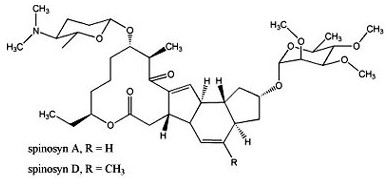Spinosad is a natural active ingredient of microbial origin used in veterinary medicine in dogs and livestock against some external parasites (lice, fleas, flies, etc.). It is also used against agricultural and household pests. It belongs to the chemical class of the spinosyns.
Common name: SPINOSAD
Type: Pesticide or veterinary medicine, depending on usage
Chemical class: spinosyn
CHEMICAL STRUCTURE

EFFICACY AGAINST PARASITES
Type of action: Contact and systemic insecticide and acaricide
Main parasites controlled: fleas, lice, mites, flies, etc.
Efficacy against a specific parasite depends on the delivery form and on the dose administered.
Click here for general information on features and characteristics of PARASITICIDES.
DOSING
Click here to view the article in this site with the most common dosing recommendations for spinosad used in domestic animals.
SAFETY
Oral LD50, rat, acute*: >3600 mg/kg
Dermal LD50, rat, acute*: >5000 mg/kg
* These values refer to the active ingredient. Toxicity has to be determined for each formulation as well. Formulations are usually significantly less toxic than the active ingredients.
MRL (maximum residue limit) set for animal tissues (e.g. beef, mutton pork or chicken)*:
- CODEX: Yes
- EU: Yes
- USA: Yes
- AUS: Yes
* This information is an indicator of the acceptance of an active ingredient by the most influential regulatory bodies for use on livestock. MRL's for animal tissues may be set also for agricultural pesticides that are not approved for use on animals but are used on commodities fed to animals. A MRL may be also set in the form of an IMPORT TOLERANCE for active ingredients not approved in a particular country but approved for imported animal commodities.
Withholding periods for meat, milk, eggs, etc. depend on delivery form, dose and national regulations. Check the product label in your country.
Learn more about spinosad safety.
General safety information for antiparasitics is available in specific articles in this site (click to visit):
- General safety of antiparasitics for domestic animals
- General safety of antiparasitics for humans
- General safety of antiparasitics for the environment
|
WARNING Never use agricultural or hygiene products with this or any other active ingredient on livestock or pets, even if there are veterinary products with this same active ingredient approved for use on animals. The formulations for agricultural or hygiene use are different and may be toxic for livestock or pets. It is obvious that veterinary products are not intended for and should never be used on humans!!! |
MARKETING & USAGE
Decade of introduction: 1990
Introduced by: ELI-LILLY, ELANCO
Some original brands: COMFORTIS, TRIFEXIS, EXTINOSAD, ELECTOR
Patent: Expired (particular formulations may be still patent-protected)
Use in LIVESTOCK: Yes, still scarce
Use in HORSES: NO
Use in DOGS and CATS: Yes, still scarce
Main delivery forms:
Use in human medicine: Yes
Use in public/domestic hygiene: Yes
Use in agriculture: Yes
Generics available: Yes
PARASITE RESISTANCE
In livestock: Yes, reported on houseflies (Musca domestica), so far only after selection in the laboratory.
In pets: No
Learn more about parasite resistance and how it develops.
SPECIFIC FEATURES
Spinosad, a mixture of spinosyn A and spinosyn D (ratio about 17:3), is a natural insecticide extracted from cultures of Saccharopolyspora spinosa, a soil bacterium.
Use in livestock is still scarce. It is available in a few countries for use in sprays, dips and pour-ons in sheep against lice and blowfly strike, and in sprays for off-animal use in poultry facilities against the fowl mites (e.g. Dermanyssus gallinae). It is also available as bait against houseflies (Musca domestica) and other nuisance flies. There are reports on good efficacy against cattle ticks (Boophilus microplus) but commercial products are not yet available for this indication.
It is also used in tablets and pills for oral administration to dogs against fleas.
It is also used in human medicines against lice (pediculosis).
Pharmacokinetics of spinosad
After oral administration, spinosad is quickly absorbed to blood. Maximum plasma levels are reached 2 to 4 hours after administration. Bioavailability is >70% and increases if administered together with food.
Spinosyn A and spinosyn D are vastly metabolized. Excretion is achieved by >80% through the feces.
Mechanism of action of spinosad
The molecular mechanism of action of spinosad has not yet been completely elucidated. It acts on both GABA and nicotinic receptors of the nerve cell membranes of insects, but it targets different subunits than other known insecticides. The good news is that spinosad has no cross-resistance with other currently available chemical classes of insecticides.
Click here to view the list of all technical summaries of antiparasitic active ingredients in this site.